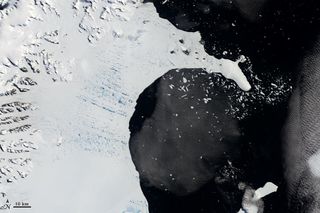Less Snow Threatens Antarctica's Fragile Ice Shelves

Antarctica's summer meltwater ponds are beautiful killers. Given an escape route down to the ice, the sapphire-blue water jacks open fractures and crevasses in ice shelves, breaking them apart.
Most ice shelves — floating, frozen plateaus permanently attached to the shore — have a thick blanket of snow that protects them from meltwater. The snow soaks up water like a sponge. But climate change may soon transform these downy snow blankets into threadbare sheets, putting more ice shelves in the Antarctic Peninsula at risk of collapse, a new study finds. The results were published today (Jan. 29) in the Journal of Glaciology.
Lead study author Peter Kuipers Munneke notes that not all of Antarctica's ice shelves are in danger of breaking apart.
"For some ice shelves, it doesn't look too good for the coming centuries," said Kuipers Munneke, a glaciologist at Utrecht University in the Netherlands. "For others, they look safe. The amount of ice shelves under the threat of collapse is dependent on the temperature increase we are going to get in the next few centuries," he told LiveScience.
Ice shelves hold back glaciers, and once they collapse, glaciers usually start galloping toward the sea, speeding their contribution to sea-level rise. [Album: Stunning Photos of Antarctic Ice]
How ice changes
There are several ways climate change can attack an Antarctic ice shelf, and the processes are different around the continent. In West and East Antarctica, warming ocean water melts and thins the ice from below. Along the Antarctic Peninsula, warming air temperatures lead to widespread summer surface melting, a precursor for ice shelf collapse, studies show. Scientists think a warmer atmosphere is the trigger for ice shelf collapse along the Antarctic Peninsula because the ocean isn't warming as much here.
Sign up for the Live Science daily newsletter now
Get the world’s most fascinating discoveries delivered straight to your inbox.
And, as Kuipers Munneke and his colleagues now show, changing snowfall patterns may thin the protective snow layer that absorbs surface water, making it easier for meltwater to eat away at the underlying ice.
Computer modeling of future climate patterns suggests that snowfall will diminish in the Antarctic Peninsula if atmospheric warming continues in the next two centuries, Kuipers Munneke and his co-authors report. Two giant ice shelves have collapsed in the peninsula in the past two decades.
With less snow every year to replace the "snow sponge," the layer will become soaked with water and meltwater can flow down to the ice, widening fissures and cracks that make the ice shelf disintegrate.
"If we continue to burn fossil fuels at the current rate, almost all ice shelves in the Antarctic Peninsula will be under threat of collapse in the next 200 years. Only the two largest ones [the Ross and Filchner-Ronne] seem to be safe," Kuipers Munneke said.
The model predicts that more snow will fall on the Ross and Filchner-Ronne Ice Shelves in the future, helping protect the ice.
Email Becky Oskin or follow her @beckyoskin. Follow us @livescience, Facebook & Google+. Original article on LiveScience.

Most Popular

